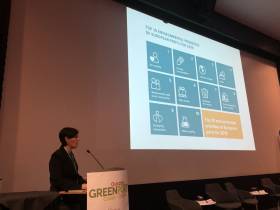Displaying items by tag: GreenPorts
The European Sea Ports Organisation today presented its annual Environmental Report for 2019 at the GreenPort Congress in Oslo, Norway.
The ESPO Environmental Report includes more than 60 different environmental performance benchmarks including figures on the green services to shipping (shore-side electricity, LNG and environmentally differentiated port dues) and the Top 10 Environmental Priorities of the European ports.
Air quality continues as the top environmental priority, followed by energy consumption. Air quality has become a key determinant of public “acceptance” of port activity in the years to come. Climate change, included in the Top 10 of the environmental priorities for the first time two years ago, is this year the third top priority after air quality and energy consumption. Almost eight out of ten European ports take climate change into consideration when they develop new infrastructure projects. Furthermore, 62% of ports strengthen the climate resilience of existing infrastructure and 47% of them have already dealt with operational challenges due to climate change. The relationship with the local community, which is of outmost importance for ports, is in position five this year. The 2019 citizen is stronger, better informed and more engaged. The local community is the new influencer and this is also for ports an important reality.
Transparency is clearly a high priority with 87% of the ports communicating their environmental policy to the stakeholders and 82% of them making it publicly available on their website. With regard to the green services to shipping, more than half of the ports are offering shore-side electricity for ships at berth (OPS), 48% of them providing high voltage electricity for seagoing vessels. One third of them has made LNG bunkering available, LNG being mainly provided by trucks (90%) and by barges (20%). In parallel, 56% of ports provide environmentally differentiated fees for ships that go beyond regulatory standards, with air emissions, waste and climate change being the main targets of these discounts.
In addition, 71% of the ports are certified with an environmental standard (ISO, EMAS, EcoPorts’ PERS) increased by 17% since 2013. 82% of ports have set up an environmental monitoring program, waste being the most monitored issue.
Aiming to further increase the transparency and accountability of the European port sector and to enhance the relationship of ports with their local communities, ESPO decided to publish the annual Environmental Report of the European port sector as from 2016. The report provides quality data on ports’ environmental performance and is becoming a point of reference for policy makers and stakeholders, including local communities, civil society, researchers and industry. 94 ports have been participating in this year’s report.
"In this year’s report, we see that ports continue to invest in green infrastructure such as shore-side electricity for ships at berth. However, we have to be aware of the increased investment costs and the technical challenges that prevent shore-side electricity from making today a strong business case. Increased costs relating to the connection with the grid and the electricity shortage at city or regional level are often additional barriers. Importantly, the price differential remains high due to level of taxation under EU Energy Taxation Directive and national levies applied to electricity price. Uncertainty on the use and the prospect of other promising technologies such as hydrogen makes it difficult to decide.
We encourage all ports to join EcoPorts in order to improve their environmental performance and better communicate their environmental policy. It will also broaden the sample of ports that feed into the annual benchmark performance of the sector.” says ESPO’s Secretary General, Isabelle Ryckbost.
The data for the report was obtained from the responses of 94 ESPO-member EU/EEA ports’ responses to the EcoPorts Self Diagnosis Method (SDM). The SDM is updated by EcoPorts’ members every two years.
The indicators included in this report feed into PortinSights, which is ESPO’s new tool for European ports to collect, share, compare and analyse their data. The digital platform includes throughput data, environmental data from EcoPorts and governance data.
























































